

· By Sip LA
The Art of Aging Wine: Is That Bottle on Your Shelf a Treasure or Trash?
Imagine uncorking a bottle of wine that's matured to perfection, its flavors deepened and complexity blossoming. That's the magic of aging wine – the art of transforming a bottle from ordinary to extraordinary. But how do you know which wines deserve a place on your shelf, destined to become treasures, and which ones are better enjoyed sooner rather than later?
The Science Behind the Wait
Wine aging is a complex dance between time, chemistry, and storage conditions. As wine rests in the bottle, several things happen:
- Tannin Softening: Tannins, naturally occurring compounds found in red wines, can make them taste astringent when young. Over time, tannins mellow, creating a smoother mouthfeel.
- Flavor Evolution: Chemical reactions within the wine create new flavor profiles. Think of it as a symphony of aromas and tastes developing over time.
- Oxidation: A small amount of oxygen exposure can enhance a wine's complexity. However, too much can lead to spoilage.
Not Every Wine is Meant to Age
While aging can elevate certain wines, it's not for all. Lighter-bodied whites, rosés, and some fruity reds are best enjoyed young, when their vibrant flavors are at their peak. Here's a general guideline:
- Reds: Bold reds with high tannins, like Cabernet Sauvignon or Syrah, are prime candidates for aging (think 5-10+ years).
- Whites: Some whites, like Chardonnay aged in oak barrels, can benefit from a few years of aging (3-7 years). However, most white wines are best enjoyed within a few years of bottling.
- Sweet Wines: Sweet wines, like Sauternes or some Rieslings, can age for decades due to their high sugar content that acts as a natural preservative.
Storage Matters: Protecting Your Potential Treasures
Proper storage is crucial for successful aging. Here's what your aging wines need:
- Cool, Dark Place: Heat accelerates the aging process and can damage the wine. Aim for a consistent temperature between 50-55°F (10-13°C) away from direct sunlight.
- Humidity: Too dry can cause corks to shrink, allowing air to enter the bottle and spoil the wine. Aim for 50-70% humidity.
- Vibration-Free Environment: Constant vibration can disrupt the delicate aging process.
Is That Bottle on Your Shelf a Treasure or Trash?
If you're unsure about a specific bottle, a quick internet search can reveal its aging potential. Look for information on the grape varietal, vintage year, and recommended drinking window.
The Takeaway: Knowledge is Power
By understanding the science of aging and the specific needs of different wines, you can transform your cellar into a treasure trove of aged delights. So, the next time you're at the wine store, consider the potential for aging – you might just discover your next bottle of liquid gold!
Yes, most wine is not meant to age. In fact, 90% of wine is intended to be consumed within a year of production, and 99% within five years. Most modern wines are made to taste great when they're released, and don't improve with age.

